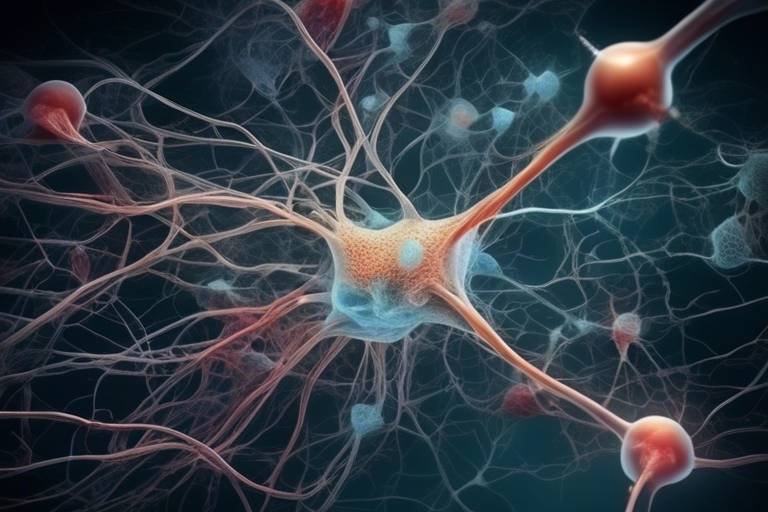Breaking Down the Entity-Relationship Model in Ontology
The Entity-Relationship (ER) model is not just a technical diagram; it’s a powerful tool that serves as a bridge between the complexities of data and the human understanding of that data. In the realm of ontology, the ER model becomes even more significant, as it helps in structuring and organizing information in a way that mirrors real-world relationships. Think of it as a map for navigating the vast landscape of data, allowing us to visualize how various entities interact and relate to one another.
At its core, the ER model comprises several key components: entities, attributes, and relationships. Each of these elements plays a crucial role in defining the overall structure of data. By breaking down these components, we can better understand how they function together to create a coherent framework for data representation. Imagine trying to piece together a jigsaw puzzle without knowing what the final picture looks like; that’s what working with data can feel like without the clarity provided by the ER model.
Moreover, the application of the ER model extends far beyond theoretical concepts. It finds practical use in various fields, including database design, knowledge representation, and even artificial intelligence. For instance, in database design, the ER model helps developers create efficient and organized data structures that ensure data integrity and consistency. In the realm of knowledge representation, it enhances the ability to interconnect disparate data sources, making it easier to retrieve and utilize information.
As we journey through the intricacies of the ER model, we will explore its components in detail, discuss its applications across different domains, and highlight the advantages it offers. By the end of this article, you will not only have a solid understanding of the ER model but also appreciate its significance in the broader context of ontology and data management.
- What is the Entity-Relationship model?
The ER model is a conceptual framework used to describe the structure of data and the relationships between different data entities. - How does the ER model benefit database design?
It helps in organizing data efficiently, ensuring data integrity and enhancing communication among stakeholders. - Can the ER model be used in artificial intelligence?
Yes, it plays a significant role in knowledge representation and improving data interoperability in AI applications.

Understanding the Entity-Relationship Model
The Entity-Relationship (ER) model is not just a technical blueprint; it's the backbone of how we organize and understand data in a structured format. Imagine walking into a library where books are scattered everywhere, with no system to find what you need. Frustrating, right? Now picture a library where every book is categorized, labeled, and easy to locate. That's precisely what the ER model does for data—it brings order to chaos.
At its core, the ER model is about representing real-world entities and the relationships between them. Think of entities as the nouns in our data story—people, places, objects, or concepts. Relationships, on the other hand, are the verbs that describe how these entities interact. For example, if we consider a school as our model, we might have entities like Students, Teachers, and Classes. The relationships could describe how students enroll in classes or how teachers instruct them. This dynamic interplay is crucial for creating a comprehensive data structure.
Another vital aspect of the ER model is the use of attributes. Attributes are the characteristics that provide more context about an entity. For instance, a Student entity might have attributes like Name, Age, and Grade. These attributes not only enrich the data but also make it more meaningful and easier to analyze.
In summary, the ER model serves as a powerful tool for data representation, allowing us to visualize and manage complex interconnections. By understanding its components—entities, relationships, and attributes—we can better appreciate how data can be structured to reflect real-world scenarios. This understanding is crucial not only for database designers but for anyone involved in data management, ensuring that we can effectively communicate and utilize the information at our disposal.

Key Components of the ER Model
The Entity-Relationship (ER) model is a powerful tool that helps us understand and visualize the structure of data in a systematic way. At its core, the ER model consists of three key components: entities, attributes, and relationships. Each of these components plays a critical role in defining how data is organized and how different pieces of information relate to one another. By grasping these elements, we can effectively create a blueprint for our data, making it easier to manage and utilize.
First, let's dive into entities. Think of entities as the main characters in our data story; they are the objects or concepts that we want to represent. For instance, in a university database, entities might include students, courses, and professors. Each of these entities has its own unique identity and can be distinguished from one another. This uniqueness is crucial, as it allows us to track and manipulate data effectively.
Next, we have attributes, which are like the details that describe our characters. Attributes provide additional information about an entity, enhancing our understanding of what it represents. For example, a student entity might have attributes such as student ID, name, date of birth, and major. These attributes not only enrich the data but also allow us to filter and sort through it effectively. Without attributes, our entities would be mere labels, lacking the depth necessary for insightful analysis.
Now, let’s talk about relationships. If entities are the characters and attributes are their traits, then relationships are the connections between these characters. They illustrate how entities interact with one another and help us understand the dynamics of our data. For instance, in our university example, a student might enroll in a course, establishing a relationship that links these two entities. Relationships can be classified into different types, such as one-to-one, one-to-many, and many-to-many, each defining the nature of the interaction. This classification is essential for accurately modeling complex data structures.
To summarize, the key components of the ER model—entities, attributes, and relationships—work together to create a comprehensive framework for data representation. Understanding these components not only aids in effective data management but also enhances our ability to make informed decisions based on that data. In the next section, we will explore the types of entities in greater detail, which will further illuminate how we can utilize the ER model to its fullest potential.

Entities: The Building Blocks
When we talk about the Entity-Relationship (ER) model, we can't overlook the pivotal role that entities play in shaping our understanding of data. Think of entities as the building blocks of the data universe. Just like how a house is constructed from bricks, data models are constructed from entities. Each entity represents a distinct object or concept that exists in the real world, making it easier to organize and manipulate data effectively.
Entities can be anything from a person, a product, an event, or even a concept like a transaction. For instance, in a university database, entities might include students, courses, and professors. Each of these entities has its own unique characteristics and plays a specific role in the system. By defining these entities clearly, we create a structured environment where data can be efficiently stored and retrieved.
Moreover, entities are not just isolated elements; they are interconnected through relationships. This interconnectivity allows us to represent complex data interactions. For example, a student entity might be related to a course entity through an enrollment relationship, demonstrating how students engage with the courses they take. This dynamic representation is crucial for understanding the data's context and significance.
Entities can be further categorized into strong and weak entities. Strong entities can exist independently and have a unique identifier, while weak entities depend on strong entities for their identification. For instance, consider a department as a strong entity that can exist on its own, whereas a course might be a weak entity that requires a department to exist. This classification helps in modeling complex relationships more effectively, allowing for a clearer representation of how different data points interact.
In addition to their classification, entities also possess attributes. Attributes are the details that describe the entity, adding depth and context to the data. For example, a student entity might have attributes such as name, student ID, date of birth, and major. These attributes enhance the overall utility of the ER model by providing essential information that can be used for queries, reports, and analysis.
In summary, entities are the fundamental components of the ER model, serving as the foundation for data representation. They provide clarity and structure, allowing us to visualize and manage data relationships effectively. Whether you’re designing a database or developing an ontology, understanding entities and their attributes is crucial for creating a robust data architecture.
- What is an entity in the ER model?
An entity is a real-world object or concept that can be distinctly identified. It serves as a fundamental component in the Entity-Relationship model.
- What are the types of entities?
Entities can be classified as strong and weak entities, depending on their independence and identification requirements.
- How do attributes relate to entities?
Attributes are properties or characteristics that provide additional information about an entity, enhancing its description within the data model.
- Why are entities important in data modeling?
Entities are crucial because they help organize data, define relationships, and enhance clarity in data representation.

Types of Entities
When we dive into the world of the Entity-Relationship (ER) model, one of the most fascinating aspects is the classification of entities. Think of entities as the characters in a story; each one plays a vital role in the narrative of data representation. In the realm of the ER model, entities can be broadly categorized into two main types: strong entities and weak entities.
Strong entities are those that have a distinct existence and can be identified independently of other entities. They possess a primary key, which is a unique identifier that distinguishes them from other entities. For example, consider a Customer entity in a retail database. Each customer has a unique customer ID, allowing us to track their purchases and preferences without relying on any other entity. Strong entities form the backbone of the ER model, as they establish the foundation upon which relationships are built.
On the flip side, we have weak entities. These entities cannot be identified solely by their own attributes and rely on a strong entity for their identification. Weak entities often have a partial key, which is a set of attributes that, when combined with the primary key of the strong entity, uniquely identifies them. For instance, think of an Order Item entity that is part of a larger Order entity. The order item cannot exist without the order itself, as it is dependent on it for its identity. This relationship showcases how weak entities play a crucial role in representing complex data structures.
To further clarify the differences, let’s take a look at the following table:
| Type of Entity | Definition | Example |
|---|---|---|
| Strong Entity | Can exist independently and has a primary key. | Customer (with unique Customer ID) |
| Weak Entity | Depends on a strong entity for identification and has a partial key. | Order Item (identified by Order ID and Item Number) |
Understanding these types of entities is crucial for effectively modeling complex data relationships within ontologies. By recognizing the strengths and dependencies of each entity type, data architects can create more robust and interconnected data models. This clarity not only enhances the representation of data but also improves the overall functionality of databases and applications that rely on these models.
- What is the difference between strong and weak entities?
Strong entities can be identified independently with a primary key, while weak entities depend on strong entities for their identification using a partial key.
- Why are weak entities important in the ER model?
Weak entities help in modeling complex relationships and dependencies in data, ensuring that all relevant information is captured accurately.
- Can an entity be both strong and weak?
No, an entity is classified as either strong or weak based on its ability to exist independently or its reliance on another entity.

Entity Attributes
In the realm of the Entity-Relationship (ER) model, attributes are like the spice that adds flavor to a dish. They provide essential information about an entity, enriching our understanding of what that entity truly represents. Think of an entity as a person; while their name and age are crucial, attributes such as their hobbies, profession, and favorite color paint a more vivid picture. In data modeling, attributes help define the characteristics of entities, making them indispensable for effective data representation.
Attributes can be categorized into several types, each serving a unique purpose in data modeling:
- Simple Attributes: These are indivisible and contain a single value, like a person's first name or birth date.
- Composite Attributes: These can be broken down into smaller sub-parts, such as a full address, which can include street, city, and zip code.
- Derived Attributes: These are calculated from other attributes, like age, which can be derived from a person's birth date.
- Multivalued Attributes: These can hold multiple values for a single entity, such as a person having several phone numbers.
Understanding these types of attributes is crucial for accurately modeling complex data relationships. For instance, when designing a database for a library system, the Book entity might have attributes like Title, Author, ISBN, and Publication Year. Each of these attributes contributes to a comprehensive understanding of the book, allowing for efficient data retrieval and management.
Furthermore, the significance of attributes extends beyond mere data storage. They play a pivotal role in the integrity and quality of the data. For example, using constraints on attributes—like ensuring that a Email Address attribute follows a specific format—helps maintain data consistency and reliability across the database. This is where the ER model shines, as it allows developers to enforce such rules effectively.
In summary, attributes are not just supplementary details; they are fundamental components that enhance the richness of data representation within the ER model. By carefully defining and categorizing attributes, we can create a robust framework that not only captures the essence of real-world entities but also facilitates effective data management and analysis.
1. What are entity attributes?
Entity attributes are characteristics or properties that provide additional information about an entity in the Entity-Relationship model.
2. Why are attributes important in data modeling?
Attributes are crucial because they enhance the understanding of entities, improve data quality, and help maintain data integrity.
3. Can attributes have multiple values?
Yes, some attributes, known as multivalued attributes, can hold multiple values for a single entity, such as a person having several email addresses.
4. How do derived attributes work?
Derived attributes are calculated from other attributes; for instance, age can be derived from a person's birth date.

Relationships: Connecting Entities
In the fascinating world of the Entity-Relationship (ER) model, relationships serve as the vital threads that weave together the various entities, creating a rich tapestry of interconnected data. Think of relationships as the social network of your data—just like people form connections, entities interact with one another, and these interactions define how data is organized and understood. Without relationships, entities would exist in isolation, much like islands in an ocean, lacking the bridges that allow for communication and interaction.
Relationships can be categorized into several types, each serving a unique purpose in data representation. The most common types include:
- One-to-One (1:1): In this type of relationship, a single entity from one set is associated with a single entity from another set. For instance, consider a scenario where each employee in a company has one unique identification number. Here, each employee corresponds to one ID, and vice versa.
- One-to-Many (1:N): This is perhaps the most prevalent type of relationship. In a one-to-many relationship, a single entity is linked to multiple entities. For example, one teacher can teach multiple students, but each student is taught by one teacher.
- Many-to-Many (M:N): This relationship allows multiple entities from one set to be associated with multiple entities from another set. A classic example is students and courses—students can enroll in multiple courses, and each course can have multiple students.
Understanding these relationships is crucial for effectively modeling complex data systems. They not only help in defining how entities are related but also in establishing the rules that govern these interactions. For instance, in a university database, the relationships between students, courses, and professors can be modeled to accurately reflect the dynamics of academic life. This clarity is essential for maintaining data integrity and ensuring that the database can handle queries efficiently.
Moreover, relationships come with their own set of attributes, often referred to as relationship attributes. These attributes provide additional context about the nature of the interaction. For example, in a relationship between a student and a course, attributes could include the enrollment date or the grade achieved. These details enrich the data model, allowing for more nuanced queries and analysis.
In summary, relationships are the connective tissue of the ER model. They not only define how entities interact but also enhance the overall structure and functionality of the data model. By understanding and effectively utilizing relationships, organizations can create robust databases that serve their needs, making data management not just a task but a strategic advantage.

Applications of the ER Model in Ontology
The Entity-Relationship (ER) model is not just a theoretical construct; it has practical applications across various domains that enhance data management and representation. In today’s data-driven world, organizations are constantly seeking ways to optimize their data structures, and the ER model provides a robust framework to achieve this. From database design to knowledge representation, the versatility of the ER model is evident in its widespread use. Let's dive deeper into some specific applications that showcase its significance.
One of the most prominent applications of the ER model is in database design. When creating a database, the ER model helps in visualizing the data structure, allowing developers to identify the entities, their attributes, and the relationships between them. This visualization not only simplifies the design process but also ensures that the database is logically sound and efficient. By mapping out these elements, developers can create a schema that accurately reflects the real-world scenarios they aim to model. For instance, consider a simple online bookstore; the entities might include Books, Authors, and Customers, with relationships that define how these entities interact.
Furthermore, the ER model plays a crucial role in knowledge representation, particularly in the realms of artificial intelligence and the semantic web. Here, the model helps in structuring knowledge in a way that machines can understand, thereby facilitating better data interoperability. By defining entities and their relationships, the ER model allows for the creation of knowledge bases that can be queried and understood by AI systems. For example, a knowledge representation system might use the ER model to link scientific concepts with research papers and authors, enabling efficient information retrieval and analysis.
In addition to these applications, the ER model is also beneficial in information retrieval. By structuring data effectively, it enhances the ability to search and retrieve relevant information quickly. Imagine trying to find a specific book in a vast library; without a well-organized system, it would be a daunting task. The ER model ensures that data is not only well-organized but also easily accessible, allowing users to find what they need without unnecessary hassle.
As we can see, the applications of the ER model in ontology are vast and varied. Its ability to provide a clear structure for data representation makes it an invaluable tool in numerous fields. Whether it's designing a database, representing knowledge, or improving information retrieval, the ER model continues to be a cornerstone of effective data management.
- What is the primary purpose of the ER model? The ER model is primarily used to visually represent data structures, helping to define entities, attributes, and relationships in a clear and organized manner.
- How does the ER model enhance database design? By providing a clear framework for identifying and organizing data elements, the ER model simplifies the database design process and ensures logical consistency.
- Can the ER model be used in artificial intelligence? Yes, the ER model is instrumental in knowledge representation, aiding AI systems in understanding and processing data effectively.

Database Design
The Entity-Relationship (ER) model plays a pivotal role in , acting as a blueprint for organizing data efficiently. Imagine trying to build a house without a plan; it would be chaotic and prone to errors. Similarly, without a structured approach like the ER model, database creation can lead to disorganized data that is hard to manage and retrieve. The beauty of the ER model lies in its ability to visually represent the data structure, making it easier for developers to understand the relationships between different entities.
When we talk about database design, we’re not just discussing the arrangement of data; we’re also considering how that data interacts. The ER model allows developers to identify entities, which are the objects or concepts that hold data, and relationships, which describe how these entities connect with each other. For instance, in a school database, you might have entities like Students, Courses, and Instructors. Each of these entities can be linked through various relationships, such as a student enrolling in a course or an instructor teaching a course.
Moreover, understanding the relationships is crucial for ensuring data integrity and consistency. For example, if a student drops a course, the relationship must be updated to reflect this change, ensuring that the database remains accurate. This dynamic interaction is what makes the ER model indispensable in database design.
To illustrate how the ER model aids in database design, consider the following table that outlines the key components of a simple school database:
| Entity | Attributes | Relationships |
|---|---|---|
| Student | ID, Name, Age, Major | Enrolled in Course |
| Course | Course ID, Title, Credits | Taught by Instructor |
| Instructor | ID, Name, Department | Teaches Course |
This table not only summarizes the entities and their attributes but also highlights how they interact with one another. Such clarity is essential for developers when creating the actual database schema. By using the ER model, developers can ensure that all necessary data points are captured and that the relationships between them are well-defined.
In summary, the ER model is a foundational tool in database design, providing a structured approach to organizing and managing data. It helps in visualizing the data landscape, ensuring that developers can create efficient, reliable databases that meet the needs of users. Just like a well-planned blueprint leads to a sturdy house, a well-structured ER model leads to a robust database system.
- What is the primary purpose of the ER model? The ER model is designed to visually represent data structures and the relationships between different data entities, making it easier to organize and manage databases.
- How do entities and relationships interact in the ER model? Entities represent real-world objects, while relationships describe how these entities connect. For example, a student enrolls in a course, establishing a relationship between the two entities.
- Can the ER model be used for complex databases? Absolutely! The ER model is versatile and can be adapted to represent complex relationships in large databases, making it a valuable tool for developers.

Knowledge Representation
In the realm of artificial intelligence and the semantic web, is a fundamental concept that allows systems to mimic human understanding of the world. The Entity-Relationship (ER) model plays a pivotal role in this domain, acting as a bridge between raw data and meaningful insights. By structuring information in a way that mirrors real-world relationships, the ER model enhances a system's ability to process, interpret, and utilize data effectively.
Imagine trying to navigate a vast library without a catalog. It would be chaotic, right? The ER model serves as that catalog, organizing knowledge into a coherent structure. It helps in defining how different pieces of information relate to one another, making it easier for machines to understand context and relevance. This structure is particularly beneficial when dealing with complex datasets, where the relationships between entities can be intricate and multifaceted.
One of the most significant advantages of using the ER model in knowledge representation is its ability to foster interoperability. In a world where data is generated from countless sources, ensuring that different systems can communicate effectively is crucial. The ER model provides a standardized way to represent data, making it easier for various platforms to exchange and interpret information. For instance, when a healthcare system integrates patient records from different hospitals, the ER model ensures that the data is consistent and understandable across all systems involved.
Moreover, the visual nature of the ER model aids in knowledge representation by providing clear diagrams that illustrate the relationships among entities. This visual representation is not just helpful for developers but also for stakeholders who may not have a technical background. By using diagrams, everyone involved can grasp the structure and flow of information quickly, leading to improved collaboration and decision-making.
To further illustrate the impact of the ER model on knowledge representation, consider the following table that highlights its key benefits:
| Benefit | Description |
|---|---|
| Improved Interoperability | Standardized data representation allows different systems to communicate seamlessly. |
| Enhanced Clarity | Visual diagrams simplify complex data relationships, making them easier to understand. |
| Efficient Data Retrieval | Structured data makes it easier to query and retrieve relevant information quickly. |
| Facilitated Collaboration | Clear representations foster better communication among technical and non-technical stakeholders. |
In summary, the Entity-Relationship model is not just a tool for database design; it is a powerful framework for knowledge representation that enhances our ability to organize, understand, and utilize data in various applications. By leveraging the ER model, organizations can ensure that their data is not only well-structured but also meaningful and actionable.
- What is the Entity-Relationship model?
The Entity-Relationship model is a conceptual framework used to represent and structure data in a way that illustrates the relationships between different entities.
- How does the ER model aid in knowledge representation?
The ER model helps in organizing data by defining entities and their relationships, making it easier for systems to understand and process information.
- What are the advantages of using the ER model?
Some advantages include improved data integrity, enhanced communication among stakeholders, and better interoperability between systems.

Advantages of Using the ER Model
The Entity-Relationship (ER) model offers a plethora of advantages that can significantly enhance the way we manage and represent data. Imagine trying to navigate a sprawling city without a map; you'd likely get lost in the maze of streets and buildings. Similarly, the ER model acts as a detailed map for data, providing clarity and structure. One of the standout benefits is its ability to ensure data integrity. By enforcing constraints, the ER model helps maintain the accuracy and consistency of data across various datasets. This is crucial because, in a world where decisions are increasingly data-driven, having reliable information is non-negotiable.
Furthermore, the ER model excels in promoting clear communication among developers, stakeholders, and users. When you visualize the relationships and attributes through ER diagrams, complex data becomes much more digestible. It's like turning a dense novel into a concise summary; the essence remains, but the clarity is vastly improved. This visual representation not only aids in understanding but also facilitates collaboration in projects. Stakeholders can easily grasp the data structure and relationships, leading to informed decision-making.
Another significant advantage of the ER model is its adaptability across different domains. Whether you're designing a database for a small business or developing a large-scale enterprise system, the ER model provides a flexible framework that can be tailored to meet specific needs. It’s akin to a Swiss Army knife—compact yet versatile, equipped to handle a variety of tasks without compromising functionality.
Moreover, the ER model enhances data retrieval efficiency. When data is well-structured, retrieving specific information becomes a breeze. Think of it as organizing your closet: when everything has its place, finding that favorite shirt is quick and easy. In the same way, well-defined entities and relationships within the ER model streamline the process of querying databases, leading to faster and more efficient data access.
To sum up, the advantages of using the ER model are profound and multifaceted. From ensuring data integrity and clarity in communication to enhancing adaptability and retrieval efficiency, the ER model stands as a cornerstone in effective data management. As we continue to navigate the complexities of data in various fields, leveraging the strengths of the ER model can pave the way for more organized, reliable, and efficient data systems.
- What is an Entity-Relationship model?
The ER model is a conceptual framework used to represent and structure data through entities, attributes, and relationships. - How does the ER model improve data integrity?
By enforcing constraints on data entries, the ER model helps maintain consistency and accuracy across datasets. - Can the ER model be used in any industry?
Yes, the ER model is versatile and can be applied in various fields such as healthcare, finance, and information technology. - What are the main components of the ER model?
The main components include entities, attributes, and relationships, each playing a vital role in data representation.

Data Integrity and Consistency
When it comes to managing data, the importance of data integrity and consistency cannot be overstated. These two concepts are the backbone of any reliable data management system, ensuring that the data remains accurate and trustworthy over time. In the context of the Entity-Relationship (ER) model, data integrity is achieved through the establishment of rules and constraints that govern how data can be entered, modified, and deleted. This is crucial because even a small error can lead to significant discrepancies, much like a single misstep in a dance can throw off an entire performance.
One of the primary ways the ER model promotes data integrity is through the use of primary keys and foreign keys. A primary key uniquely identifies each record in a table, while a foreign key creates a link between two tables, ensuring that the data across these tables remains consistent. For instance, if you have a table of Customers and another of Orders, the foreign key in the Orders table that refers back to the Customers table ensures that every order is associated with a valid customer. This relationship is vital for maintaining the integrity of the data.
Moreover, the ER model allows for the implementation of various constraints, such as unique constraints, check constraints, and not null constraints. These constraints act as gatekeepers, preventing invalid data entries that could compromise the integrity of the database. For example:
- Unique Constraints: Ensure that certain fields, like email addresses, remain unique across records.
- Check Constraints: Validate that the data entered falls within a specified range, such as age being greater than zero.
- Not Null Constraints: Ensure that essential fields must have a value, preventing incomplete records.
Consistency is another critical aspect that the ER model addresses. By enforcing rules and relationships among entities, the model ensures that any changes made to the data are reflected throughout the system. This means that if a customer's information is updated in one place, it will automatically update in all related records, preventing any inconsistencies that could arise from outdated information. Imagine trying to solve a puzzle where pieces don’t fit together; that’s what inconsistent data can feel like. The ER model ensures that all pieces of the data puzzle align perfectly.
Furthermore, the visual representation of the ER model helps in identifying potential integrity issues before they become problematic. By using diagrams, developers can see how entities relate to one another, making it easier to spot any discrepancies or areas where data integrity may be at risk. This proactive approach to data management is akin to having a roadmap that guides you through a complex city, helping you avoid getting lost in the maze of data.
In conclusion, the Entity-Relationship model plays a pivotal role in ensuring data integrity and consistency. By establishing clear rules and relationships among entities, it not only protects the accuracy of the data but also enhances the overall reliability of the database. In a world where data is king, maintaining its integrity is essential for any organization aiming for success.
- What is data integrity? Data integrity refers to the accuracy and consistency of data over its lifecycle, ensuring that it remains reliable and trustworthy.
- How does the ER model ensure data consistency? The ER model enforces relationships and constraints that help maintain consistency across related data entries, automatically updating information when changes occur.
- Why are primary keys important? Primary keys uniquely identify each record in a table, preventing duplicate entries and ensuring that data can be accurately referenced.
- What are constraints in the ER model? Constraints are rules applied to data fields that enforce certain conditions, such as uniqueness or the requirement for a value, to maintain data integrity.

Enhanced Communication
When it comes to navigating the complex world of data, communication is key. The Entity-Relationship (ER) model shines in this aspect by providing a visual representation that simplifies the intricate relationships between data elements. Imagine trying to explain a complicated web of connections without a diagram; it would be like trying to describe a beautiful painting using only words. The ER model acts as that painting, allowing everyone involved—developers, stakeholders, and users—to grasp the system's architecture at a glance.
One of the most significant advantages of using the ER model is its ability to foster collaboration among team members. By utilizing clear diagrams that illustrate entities and their relationships, teams can engage in productive discussions, pinpointing potential issues and brainstorming solutions efficiently. This visual clarity eliminates ambiguity, ensuring that all parties are on the same page. In fact, studies have shown that teams that employ visual aids in their communication tend to be more effective and achieve better outcomes.
Moreover, the ER model serves as a universal language for data representation. Whether you're a seasoned database designer or a newcomer to the field, the fundamental concepts of entities, attributes, and relationships remain consistent. This consistency allows for smoother transitions between different projects and teams, as everyone can easily understand the model without extensive training. It's like having a common dialect that everyone speaks, making collaboration feel less daunting.
Additionally, the ER model enhances communication by providing a structured framework for documentation. Proper documentation is crucial in any project, as it serves as a reference point for current and future team members. By incorporating ER diagrams into the documentation, teams can create a comprehensive guide that not only explains the data structure but also illustrates how each component interacts. This is particularly beneficial in large projects where new members may join at various stages, ensuring that they can quickly get up to speed.
To sum it up, the ER model is more than just a tool for data representation; it is a catalyst for enhanced communication. By providing visual clarity, fostering collaboration, establishing a universal language, and supporting thorough documentation, the ER model plays a pivotal role in ensuring that everyone involved in a project can effectively communicate and contribute to its success.
- What is the Entity-Relationship model?
The Entity-Relationship model is a conceptual framework used to represent data and its relationships in a structured manner, often visualized through diagrams. - How does the ER model improve communication?
By providing clear visual representations of data relationships, the ER model helps stakeholders understand complex data structures, facilitating better discussions and collaboration. - Can the ER model be used in any domain?
Yes, the ER model is versatile and can be applied in various fields, including database design, artificial intelligence, and knowledge representation. - What are the key components of the ER model?
The key components include entities, attributes, and relationships, each playing a critical role in defining how data is structured.
Frequently Asked Questions
- What is the Entity-Relationship (ER) model?
The Entity-Relationship (ER) model is a conceptual framework used to structure and represent data. It helps in visualizing how different entities relate to one another, making it easier to design databases and manage information effectively.
- What are the main components of the ER model?
The ER model consists of three primary components: entities, attributes, and relationships. Entities are objects or concepts, attributes provide details about these entities, and relationships illustrate how entities interact with each other.
- How do entities differ from attributes in the ER model?
Entities are the core objects that represent real-world items or concepts, while attributes are the characteristics or properties that provide more information about those entities. Think of entities as the nouns in a sentence, and attributes as the adjectives that describe them.
- Why are relationships important in the ER model?
Relationships are crucial because they define how entities interact with one another. They help in capturing the dynamics of data and provide a clear understanding of how different elements are interconnected, which is essential for effective data management.
- What are the applications of the ER model?
The ER model is widely used in various fields, including database design, knowledge representation, and information retrieval. It aids in organizing data efficiently, enhancing interoperability in AI systems, and improving overall data management practices.
- How does the ER model enhance data integrity?
The ER model promotes data integrity by enforcing constraints and ensuring that data remains consistent across different datasets. This helps in maintaining reliable information, which is vital for any data-driven application.
- Can the ER model improve communication among stakeholders?
Absolutely! The visual representation of the ER model makes it easier for developers, stakeholders, and users to understand complex data relationships. Clear diagrams foster collaboration and ensure everyone is on the same page when it comes to data management.



















